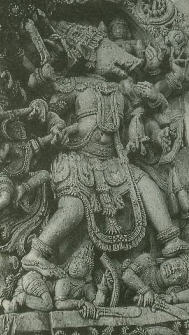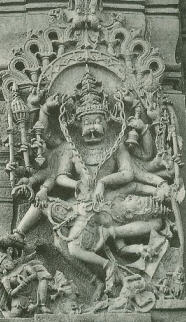It took a century to build, and eight centuries have not diminished its grandeur.
THE TWELFTH-CENTURY Visnu temple at Belur, in the Indian state of Karnataka, was built by the Hoysala king Vishnuvardhana. The Hoysalas were originally a tribe of the Western Ghats, the mountain chain that runs along the west coast from Gujarat to the southern tip of India. In the twelfth and thirteenth centuries the Hoysalas came to rule that part of the Deccan. King Vishnuvardhana converted from Jainism to Vaisnavism, as taught by Sri Ramanuja, around the time when Ramanuja publicly defeated the Jain texts.
Sri Channa Kesava, the nine-foot-tall Deity in the temple, is still worshiped, but not with the splendor of seven hundred years ago. The temple is maintained by the government of India, and has become a tourist attraction. It's a small, squat, star-shaped structure on a raised platform. Although small compared to other South Indian temples, with their the towering gopurams (ornate gateways), it's covered within and without with distinctive, intricate, and expressive stone sculpture, glorifying the pastimes of the Lord. The sculpture indicates how refined were art, music, and dance in the Vaisnava culture at that time.

Lord Varaha Dev
It took 103 years to build the temple, begun in 1117. The inside is dark and cool, with forty-eight pillars, each unique in shape and design, carved with elaborate bas reliefs. All around the walls are high stone ledges and steep steps, sitting places for worshipers and observers. In the center before the Deity is a smooth, round, black stone platform where dancers performed for the pleasure of the Deity. On the ceiling above, lit by a spotlight, is a big rosette carved from a single stone. Lord Nrsimhadeva is at its center. In each corner of the rosette is a female dancer, one being the queen of Vishnuvardhana, Shantiladevi, who used to dance before the Deity. The other dancers are Gandharva Kanya, a heavenly maiden; Mayuri, a maiden with a peacock at her side and a parrot on her hand; and Kesava Srngari, a maiden dressing her hair, wet from bathing, and wearing stone bangles on her wrist.
Over the silver doors to the shrine of the Deity stand are two guardian beasts, each formed of seven animals in one cow's ears, elephant's trunk, lion's paws, crocodile's tail, and so on. Beside the doors stand graceful seven-foot sculptures of Jaya and Vijaya, the gatekeepers of Visnu, slightly bent at the waist, with long delicate fingers, their beautiful expressions making them look alive.
On the outside of the temple are the forms and incarnations of Lord Visnu. Lord Nrsmhadeva, the half-man, half-lion incarnation, is carved in such minute detail that His nails plunge deep into Hiranyakasipu's knee. The demon's entrails garland the Lord's neck. There are scenes from the Ramayana and the Mahabharata, and pastimes of Lord Krsna. Arjuna stands with his bow, its string worn away by the touch of hundreds of thousands of pilgrims. And Visakanya, a poisonous maiden, has a scorpion biting her toe.
Around the base of the temple are friezes, three high, of elephants for patience, lions for strength, and horses for speed. Each animal is unique. At the four entrance doors are sculptures of a boy fighting a lion.
In the courtyard a flame burns atop a tall stone pillar, and from the gate tower a loudspeaker plays devotional songs.
Behind the main temple is the temple of goddess Laksmi, the consort of Lord Channa Kesava.
Visiting Belur

Crowds of tourists come by bus to see the carvings of the Channa Kesava Temple. Official temple guides speak to large groups in several languages, though usually in Telegu and Kannada, the languages of the region. There's no fee for the tour, but you can give a donation. The guides are busy, so it's hard to find one who'll give a complete tour in English for just a couple of people. But the guides are knowledgeable, so it's worth the wait.
During my visit, a brahmana ran here and there charging four rupees to shine a spotlight and ten rupees for his barely understandable English commentary. As I viewed a gold-painted wooden Sesa Naga, the serpent-couch of Visnu, the brahmana said, "Sesa Naga" and threw a couple of coins into the serpent's coils, inplying that I should follow this example.
Belur is a small town four hours west of Bangalore, four hours north of Mysore, and about six hours by state transport bus from Udipi through the gorgeous scenery of the Western Ghats. The area is poor, and there are many small hotels with tiny rooms for forty rupees a night. You're given a bucket of hot water for your morning bath.
The Karnataka State Tourist Department hotel is ninety rupees, but you'll need advance booking. Its restaurant is nonvegetarian. The Hotel Gayatri on the main street has good, cheap vegetarian meals and can give helpful information about bus timings and routes.
Lavangalatika Devi Dasi, an American disciple of Srila Prabhupada, was a leading distributor of his books for many years. She and her husband now live in Bombay.
